Top 10 Foods Highest in Choline
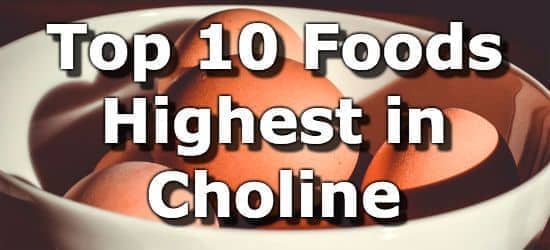
Choline is an essential nutrient necessary for a wide range of functions including cellular maintenance, liver function, creating neurotransmitters, and regulating homocysteine metabolism. (1,2)
Due to its role in brain development in the early stages of life, adequate choline levels are particularly essential for pregnant women. (3,4)
While rare, a deficiency in choline often causes an increase in the levels of certain liver enzymes in the blood, which indicates liver damage. Besides the liver, the heart and nervous system are also affected by choline deficiency. (2)
While more research needs to be conducted, preliminary studies suggest that the health benefits of adequate choline intake include a reduced risk of dementia and cancer. (1,5,6)
Note: As with many nutrients, more choline is not always better, and it's possible to get too much. The tolerable upper limits are 1000mg per day for children, 2000mg for teenagers, and 3500mg for adults. (3)
High choline foods include lean chicken, fish, lean pork, eggs, beef, shrimp, beans, low-fat milk, broccoli, and green peas. The daily value (DV) for choline is 550mg per day. (7)
Below is a list of common foods high in choline. For more see the extended list of choline rich foods, and the complete ranking of 200 foods high in choline.
List of Foods High in Choline
-
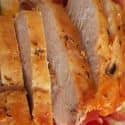 1. Lean Chicken Breast + Add
1. Lean Chicken Breast + Add
Choline
in a 6oz BreastCholine
per 100gCholine
per 200 Calories198.9mg
(36% DV)117mg
(21% DV)149mg
(27% DV)More Poultry High in Choline
- 33% DV in a roasted chicken leg
- 17% DV in a chicken wing
- 17% DV in a chicken thigh
See all meats high in choline.
-
 2. Fish (Salmon) + Add
2. Fish (Salmon) + Add
Choline
per 6oz FilletCholine
per 100gCholine
per 200 Calories191.4mg
(35% DV)112.6mg
(20% DV)144.4mg
(26% DV)More Fish High in Choline
- 27% DV in a 6oz cod fillet
- 24% DV in a 6oz tuna fillet
- 20% DV in a 5oz herring fillet
See all fish high in choline.
-
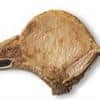 3. Lean Pork Chops + Add
3. Lean Pork Chops + Add
Choline
in a 6oz ChopCholine
per 100gCholine
per 200 Calories152.8mg
(28% DV)89.9mg
(16% DV)92.2mg
(17% DV)More Pork Products High in Choline
- 23% DV in 1 cup of roasted ham
- 16% DV in 3oz of spam
- 15% DV in a bratwurst sausage
See all meats high in choline.
-
 4. Eggs + Add
4. Eggs + Add
Choline
in 1 Large EggCholine
per 100gCholine
per 200 Calories146.9mg
(27% DV)293.8mg
(53% DV)379.1mg
(69% DV)Note: Choline found in eggs is concentrated in the yolks. Egg whites contain very little choline.
-
 5. Beef (Skirt Steak) + Add
5. Beef (Skirt Steak) + Add
Choline
per 6oz SteakCholine
per 100gCholine
per 200 Calories132.3mg
(24% DV)77.8mg
(14% DV)58.1mg
(11% DV)More Beef Products High in Choline
- 62% DV in a 3oz slice of beef liver
- 20% DV in 3oz of chuck pot roast
See all meats high in choline.
-
 6. Shrimp + Add
6. Shrimp + Add
Choline
per 3oz (About 12 Large Shrimp)Choline
per 100gCholine
per 200 Calories115.1mg
(21% DV)135.4mg
(25% DV)227.6mg
(41% DV)More Shellfish High in Choline
- 20% DV in 1 cup of blue crab
- 17% DV in 3oz of scallops
- 16% DV in 3oz of oysters
See all fish high in choline.
-
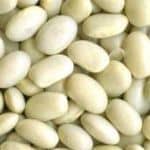 7. Navy Beans + Add
7. Navy Beans + Add
Choline
per CupCholine
per 100gCholine
per 200 Calories81.4mg
(15% DV)44.7mg
(8% DV)63.9mg
(12% DV)More Beans High in Choline
- 16% DV in 1 cup of edamame
- 15% DV in 1 cup of canned baked beans
- 13% DV in 1 cup of chickpeas (garbanzo beans)
See all beans high in choline.
-
 8. Low-Fat Milk + Add
8. Low-Fat Milk + Add
Choline
per 16oz GlassCholine
per 100gCholine
per 200 Calories80mg
(15% DV)16.4mg
(3% DV)65.6mg
(12% DV)More Dairy Products High in Choline
- 8% DV in 1 cup of buttermilk
- 7% DV in 1 cup of yogurt
- 4% DV in 1/2 cup of ricotta cheese
-
 9. Broccoli + Add
9. Broccoli + Add
Choline
per Cup CookedCholine
per 100gCholine
per 200 Calories62.6mg
(11% DV)40.1mg
(7% DV)229.1mg
(42% DV)More Cruciferous Vegetables High in Choline
- 14% DV in 1 cup of lima beans
- 13% DV in 1 cup of cooked collard greens
- 12% DV in 1 cup of brussels sprouts
See all vegetables high in choline.
-
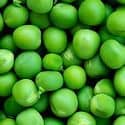 10. Green Peas + Add
10. Green Peas + Add
Choline
per Cup CookedCholine
per 100gCholine
per 200 Calories47.5mg
(9% DV)29.7mg
(5% DV)70.7mg
(13% DV)More Vegetables High in Choline
- 10% DV in 1 cup of shiitake mushrooms
- 9% DV in 1 cup of artichokes
- 9% DV in 1 cup of asparagus
See all vegetables high in choline.
Printable One Page Sheet
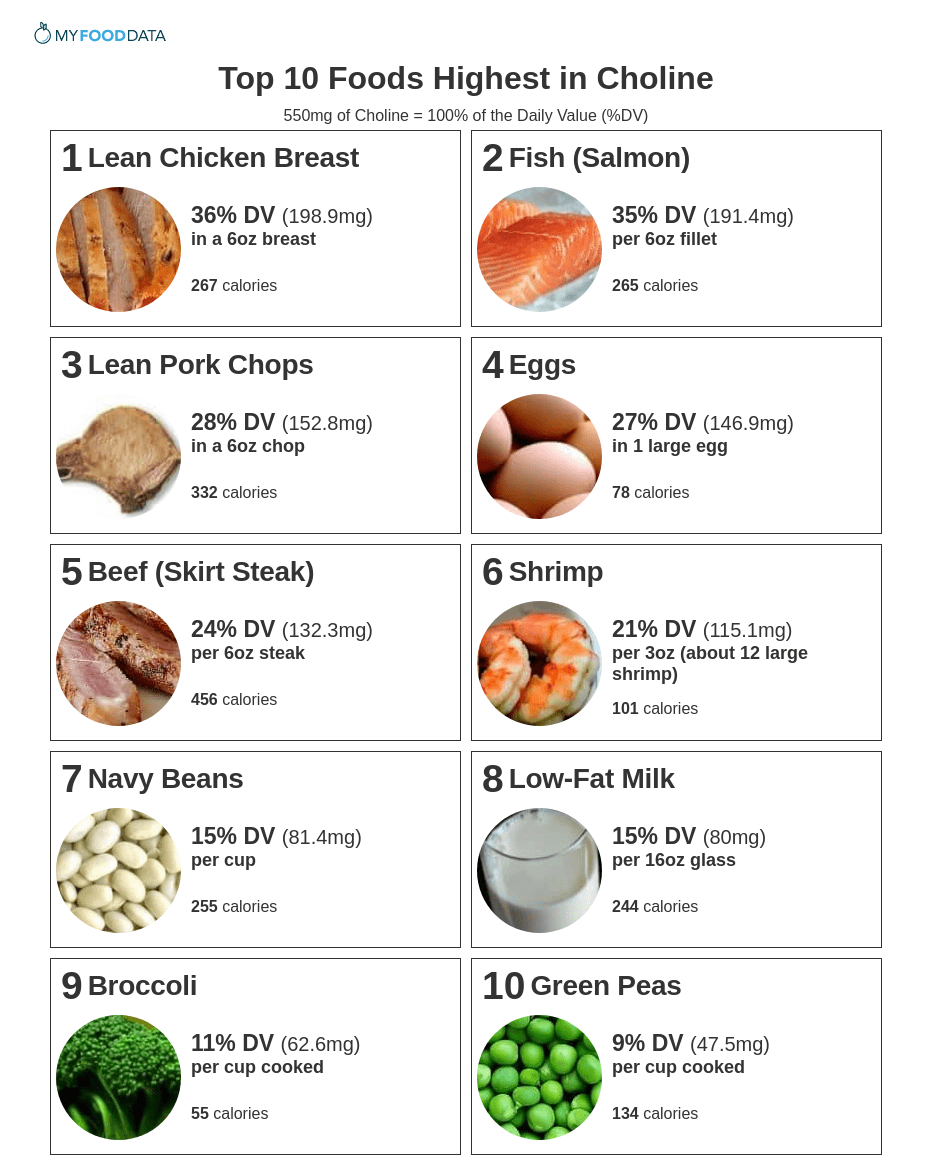
More Choline Rich Foods
| Food | Serving | Choline |
|---|---|---|
| 1. Whey Protein Isolate + | per 3 scoops (3oz) | 35% DV (193.5mg) |
| 2. Roasted Lean Buffalo + | per 3oz serving | 18% DV (97.6mg) |
| 3. Shiitake Mushrooms + | per cup cooked | 10% DV (53.4mg) |
| 4. Toasted Wheat Germ + | per oz | 9% DV (50.7mg) |
| 5. Cauliflower + | per cup cooked | 9% DV (48.5mg) |
| 6. Fish Roe (Ikura, Caviar) + | per tblsp | 9% DV (47mg) |
| 7. Oyster Mushrooms + | per cup cooked | 8% DV (41.9mg) |
| 8. Pickled Beets + | per cup | 6% DV (34.1mg) |
| 9. Sweet Corn + | per cup cooked | 6% DV (33.4mg) |
| 10. Flax Seeds + | per oz | 4% DV (22.4mg) |
Choline Requirements By Age and Gender
The adequate intake (AI) for choline ranges from 125mg to 550mg per day. The daily value for choline is 550mg per day. (7)
| Life Stage | AI |
|---|---|
| Infants | |
| 0-6 months old | 125mg |
| 7-12 months old | 150mg |
| Children | |
| 1-3 years old | 200mg |
| 4-8 years old | 250mg |
| Males | |
| 9-13 years old | 375mg |
| 14-18 years old | 550mg |
| 19-50 years old | 550mg |
| 50+ years old | 550mg |
| Females | |
| 9-13 years old | 375mg |
| 14-18 years old | 400mg |
| 19-50 years old | 425mg |
| 50+ years old | 425mg |
| Pregnancy | |
| 14-18 years old | 450mg |
| 18+ years old | 450mg |
| Lactation | |
| 14-18 years old | 550mg |
| 18+ years old | 550mg |
From the Nutrient Ranking Tool
Use the ranking tool links below to select foods and create your own food list to share or print.
- Foods High in Choline
- Foods Low in Choline
- Vegetables High in Choline
- Fruits High in Choline
- Vegetarian Foods High in Choline
- Beans High in Choline
- Dairy High in Choline
- Breakfast Cereals High in Choline
- Fast Foods High in Choline
View more nutrients with the nutrient ranking tool, or see ratios with the nutrient ratio tool.
Related
Data Sources and References
- [Importance of choline in cognitive function]
- Choline: an essential nutrient for public health
- Choline: critical role during fetal development and dietary requirements in adults
- Choline, Neurological Development and Brain Function: A Systematic Review Focusing on the First 1000 Days
- Is dietary choline intake related to dementia and Alzheimer's disease risks? Results from the Framingham Heart Study
- Choline and betaine consumption lowers cancer risk: a meta-analysis of epidemiologic studies
- U.S.FDA - Daily Value on the New Nutrition and Supplement Facts Labels
Simplify Nutrition Tracking with MyFoodData!
Speedy Tools and Detailed Data FREEEasily analyze your meals to find the best foods for your goals.
✅ Use our recipe nutrition calculator and nutrition comparison tool.
✅ Access expert nutrition data tools and in-depth articles.
✅ Log foods and organize your recipes with a free account.


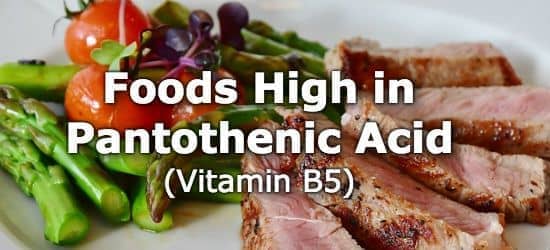 Next ➞
Next ➞
